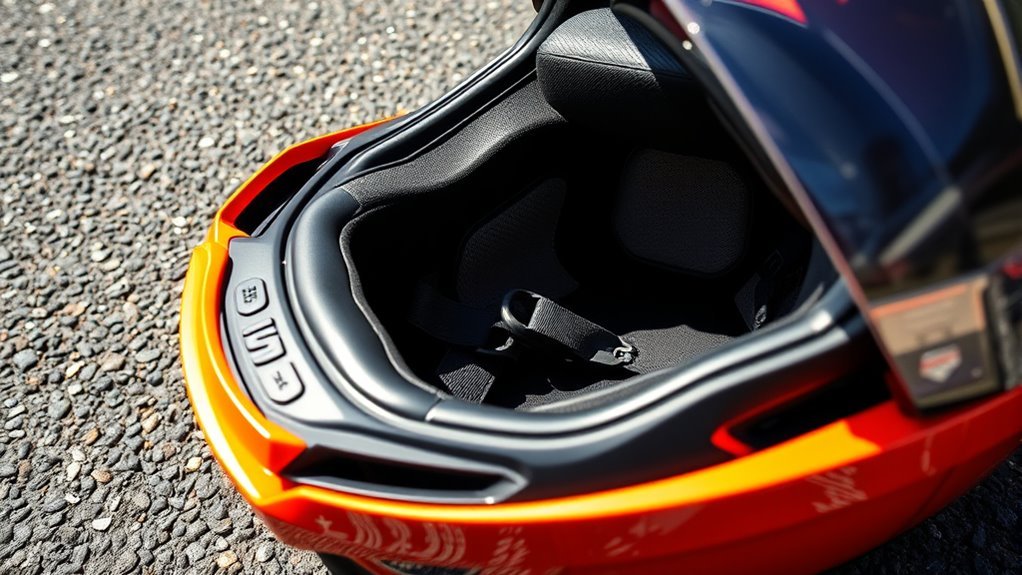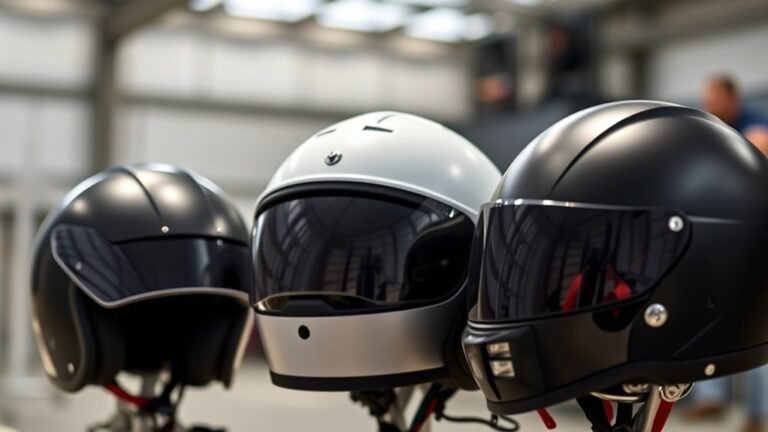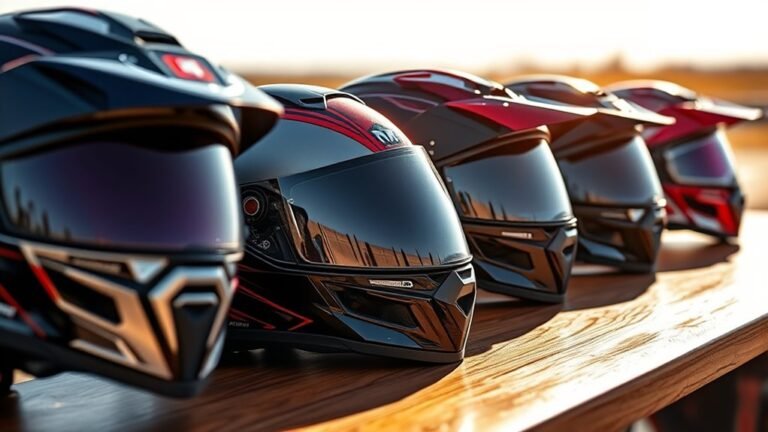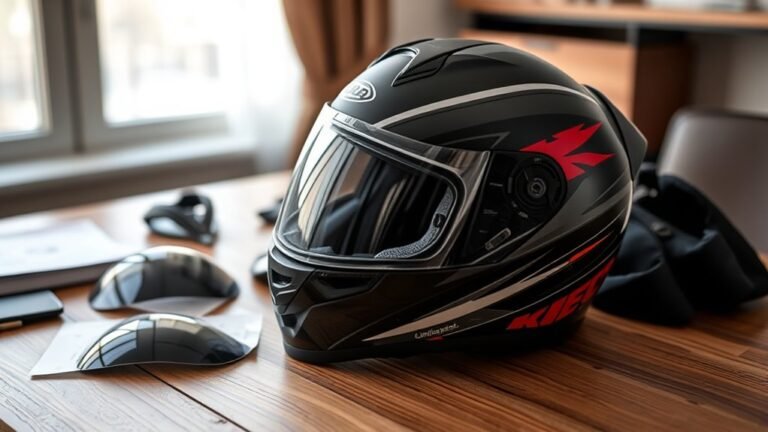Top Safety Features to Look for in a Motorcycle Helmet
When choosing a motorcycle helmet, prioritize safety features like impact resistance, proper fit, and visibility enhancements. Look for certification labels such as DOT, ECE, or Snell to guarantee compliance with safety standards. Verify a snug fit to prevent movement during rides, and opt for bright colors or reflective materials for improved visibility. Quality ventilation is essential for comfort and focus. Exploring more about these features can guide you toward making the best choice for your riding safety.
Impact Resistance and Certification Standards
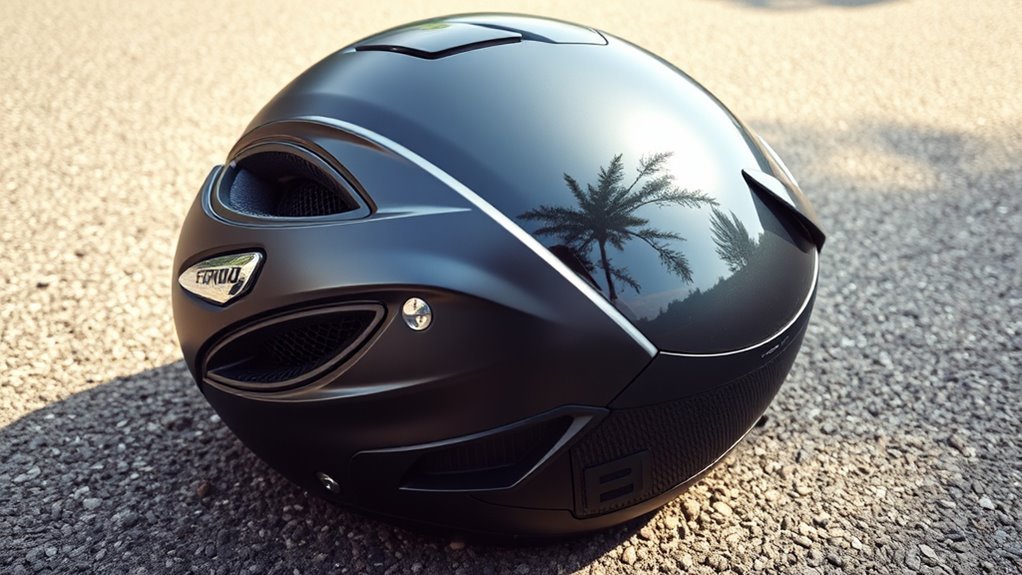
When it comes to motorcycle safety, understanding impact resistance and certification standards is essential for every rider. Helmets are your first line of defense, so you need to know how they perform in an impact. Look for helmets that feature high-quality materials designed for impact absorption, which can greatly reduce the risk of head injuries. Certification labels, like DOT, ECE, and Snell, indicate that the helmet meets specific safety standards. These labels guarantee that the helmet has undergone rigorous testing to verify its protective capabilities. Choosing a helmet with these certifications not only enhances your safety but also provides peace of mind, allowing you to ride freely and confidently. Make informed choices for your adventures on the open road.
Proper Fit and Comfort

When choosing a motorcycle helmet, selecting the correct size is vital for your safety and comfort. Quality padding and lining not only enhance the fit but also provide essential cushioning during rides. A proper fit reduces movement and guarantees that the helmet effectively protects you in the event of an accident.
Correct Size Selection
Choosing the correct size for your motorcycle helmet is essential for both safety and comfort. A helmet that’s too loose can shift during a ride, compromising protection, while one that’s too tight can cause discomfort and distract you from the road. Start with accurate size measurement; use a soft tape measure to measure the circumference of your head just above your eyebrows. Once you have your measurement, consult the manufacturer’s sizing chart. Employ fitting techniques like trying the helmet on for a snug fit, ensuring it doesn’t move when you shake your head. Remember, a properly fitted helmet enhances your freedom on the open road by offering ideal protection and comfort. So, take the time to find your perfect size.
Padding and Lining Quality
Once you’ve found the right size for your helmet, the next factor to evaluate is the quality of the padding and lining. High-quality padding materials enhance comfort, reducing fatigue during long rides. Look for helmets with multi-density foam, as it provides better shock absorption and conforms to your head’s shape. The lining should be breathable and moisture-wicking to keep you cool and dry. Lining durability is essential; make sure it’s resistant to wear and tear, which can compromise safety over time. A helmet that fits well with quality padding and durable lining not only provides comfort but also enhances your riding experience. After all, freedom on the open road starts with feeling secure and at ease.
Visibility Enhancements
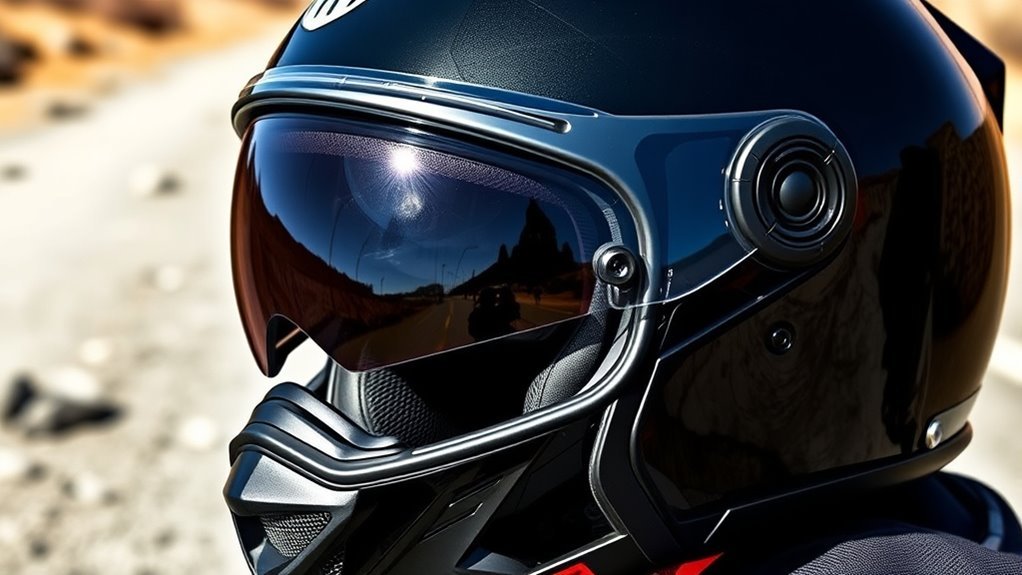
Visibility enhancements in motorcycle helmets play a crucial role in rider safety. When you’re out on the open road, you want to make sure you’re seen by others. Look for helmets that incorporate bright colors and reflective materials. Bright colors, like neon yellow or orange, make you stand out against the backdrop of the road, increasing your visibility during the day. Reflective materials, on the other hand, catch headlights at night, making it easier for other drivers to spot you. These features can greatly reduce the chances of accidents, allowing you to enjoy your ride with more confidence. Don’t underestimate the importance of visibility; it’s a simple yet effective way to enhance your overall safety on the road.
Ventilation Systems
When choosing a motorcycle helmet, you can’t overlook the importance of effective ventilation systems. A well-designed airflow system not only enhances comfort but also helps manage moisture, keeping you cool during rides. Many helmets offer adjustable ventilation options, allowing you to customize airflow to suit varying weather conditions.
Airflow Design Importance
Airflow design is a crucial aspect of motorcycle helmet safety, as effective ventilation systems can greatly enhance rider comfort and focus. When you’re cruising down the open road, you need to stay cool and alert. Proper airflow benefits you by reducing heat buildup and moisture inside the helmet, which can distract you from the ride. Helmets with quality airflow materials allow for better breathability, ensuring your head stays dry and comfortable during long journeys. Look for designs that promote ideal air circulation while maintaining structural integrity. A well-ventilated helmet not only enhances your riding experience but also contributes to safer rides by keeping you focused and aware of your surroundings. Prioritize airflow design for a more enjoyable and secure adventure.
Adjustable Ventilation Options
Effective airflow design naturally leads to the consideration of adjustable ventilation options in motorcycle helmets. These options allow you to customize airflow adjustment, ensuring comfort during your ride. When you’re cruising at high speeds, proper temperature regulation is essential to prevent overheating. Helmets featuring adjustable vents enable you to open or close ventilation as needed, adapting to changing weather conditions or your activity level. This flexibility can make a significant difference in your riding experience, keeping you focused on the road ahead rather than on discomfort. When choosing a helmet, look for models with intuitive ventilation systems that let you easily modify airflow without compromising safety. Embrace the freedom of the ride, knowing you can control your comfort.
Moisture Management Features
While riding, you might not realize how essential moisture management features are in motorcycle helmets until you experience discomfort from sweat buildup. A helmet with effective moisture-wicking materials helps keep you dry and comfortable. Look for liners that incorporate anti-bacterial properties to prevent odors and maintain freshness during long rides.
Here’s a quick comparison of moisture management features:
| Feature | Benefits | Examples |
|---|---|---|
| Moisture-Wicking Liner | Keeps sweat away from skin | Coolmax, Dryfit |
| Anti-Bacterial Properties | Reduces odor and bacteria | Silver-infused fabrics |
| Ventilation Channels | Enhances airflow | Adjustable vents |
| Removable Liners | Easy to clean and maintain | Washable helmet liners |
Choosing the right helmet with these features guarantees you ride freely without distractions.
Weight and Aerodynamics
When selecting a motorcycle helmet, understanding the balance between weight and aerodynamics is essential for both safety and comfort. A well-designed helmet not only protects but also enhances your riding experience. Pay attention to the following factors:
- Weight distribution: A helmet that evenly distributes weight reduces neck strain.
- Aerodynamic shape: This minimizes drag, allowing for smoother rides at higher speeds.
- Materials: Lightweight materials can enhance comfort without compromising safety.
- Ventilation: Proper airflow can offset additional weight while keeping you cool.
- Fit: A snug fit can improve aerodynamics and comfort, ensuring stability.
Choosing a helmet with ideal weight and aerodynamic features empowers you to ride freely and confidently on the open road.
Additional Safety Features and Accessories
As you explore motorcycle helmets, it’s essential to take into account additional safety features and accessories that can greatly enhance your protection on the road. Reflective decals, for instance, can greatly improve your visibility, especially during low-light conditions. These decals help you stand out to other drivers, adding an extra layer of safety.
Moreover, consider helmets equipped with communication systems. These allow you to stay connected with fellow riders, ensuring you’re aware of road conditions and potential hazards. Whether you’re maneuvering twisty backroads or open highways, having clear communication can be vital. By choosing helmets with these additional features, you enhance not just your safety, but also your overall riding experience, allowing you to ride with confidence and freedom.
Frequently Asked Questions
How Often Should I Replace My Motorcycle Helmet?
You should replace your motorcycle helmet every five years, even if it looks fine. Over time, the materials degrade, impacting its ability to meet helmet safety standards. If you’ve been in an accident, replace it immediately, regardless of visible damage. Regularly checking for wear and tear is essential too. Keeping to this helmet replacement frequency guarantees you stay protected while enjoying the freedom of the open road. Your safety is worth it!
Can I Wear a Used Motorcycle Helmet?
You can wear a used motorcycle helmet, but tread carefully. Think of it as donning a warrior’s shield with unknown battles. Inspect the helmet thoroughly for cracks or damage from previous ownership. If it’s older than five years or has seen a crash, it’s best to steer clear. Safety’s paramount, and a compromised helmet can turn your ride into a gamble. Trust your instincts and prioritize your freedom on the open road.
Are Colorful Helmets Safer Than Plain Ones?
Colorful helmets can be safer than plain ones, primarily due to color visibility. Bright colors enhance your visibility on the road, making it easier for drivers to see you. This increased visibility can reduce the likelihood of accidents. Additionally, helmet design plays a role; a well-designed helmet that incorporates bright colors not only looks good but also serves a practical purpose. So, when choosing a helmet, consider how color can impact your safety while riding.
How Do I Clean My Motorcycle Helmet Properly?
Cleaning your motorcycle helmet’s like polishing a prized jewel—vital for its shine and longevity. Start by removing the visor and interior padding. Use mild soap and water for the outer shell, avoiding harsh cleaning products that can damage the material. For the interior, a gentle wipe with a damp cloth suffices. Verify everything’s completely dry before reassembling. Regular cleaning isn’t just for looks; it’s essential for helmet maintenance and your safety on the road.
What’s the Lifespan of a Motorcycle Helmet?
A motorcycle helmet typically lasts about three to five years, depending on its materials and usage. Helmets made from high-quality materials like polycarbonate or fiberglass often provide better durability. It’s essential to check the impact ratings, as these ratings reflect the helmet’s ability to protect during crashes. Regularly inspect your helmet for signs of wear, and if it shows damage or has reached its lifespan, it’s time to replace it for your safety.
